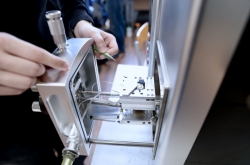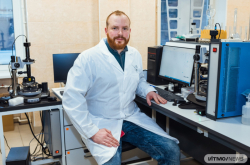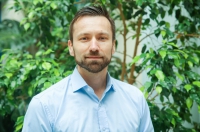How did you start working with ITMO University?
Professor Vadim Veiko, who founded the lasers laboratory at ITMO many years ago, is quite famous. We met at the Fundamentals of Laser Material Interactions and Nanotechnologies Conference; his team suggested that we do a joint project. Then, there was a competition, as is common in science. I didn’t think it would actually work on the first attempt, but it did.
What is the project you’re working on right now?
It focuses on ultra-precise nanostructuring of optical materials using ultra-short lasers, a technology which lets us create optical components, sensors, membranes and various nano-fluid devices, chips and micro-electronic components. It’s very important for biology and chemistry, among other fields.

Use of femtosecond lasers in nanostructuring. Credit: Koji Sugioka, degruyter.com
Some of the applications include laser-based waveguides and nanostructures, while others have to do with creating laser-assisted image inscription that are only visible under a particular irradiation. The former are for novel technologies in photonics and telecommunications, whereas the latter can be even used to combat counterfeiting. For instance, someone might try to copy brand perfume; a laser may be used to write information on the packaging that can be read only by a particular illumination. Such technology was already used to authenticate, for example, the shells of French oysters. There’re lots of applications in medicine, such as in nano-bio photonics, where we can create extremely clean plasmonic or magneto-plasmonic nano-particles and use them for cancer detection and local disease treatment. In addition, silicon nanoparticles formed by laser ablation not only have promising properties for diagnostics, but can be also heated with radio frequency waves to destroy tumors.
Early on in your career, you moved to France to work with lasers.
I did. Originally, I went to Marseille to work on Laser Plasma and Photonic Processing back in 1995; I’d only been to Cyprus before that. No one believed that I was going to a university to work. I was one of the first people do that, especially as a woman. I came to Marseille, a very beautiful city by the sea. My software was written in C++, but I arrived at an experimental Lab where, at the time, they didn’t have a suitable compiler, or even a Pentium, for that matter. They only had a rather old Fortran compiler for Mac, which at the time was not suitable for high-performance computing. It was a purely experimental laboratory, and they didn’t have the level of theory that I was used to. However, they had lasers, which was very exciting. In Russia, the focus was very much on theory. In France, I could actually see and touch the real lasers. It was very important for my work on laser applications.
In terms of quality of life, we all had a rose-colored impression that everything in France would be very fancy. But, for a long time, you have to live in a very frugal fashion and you have to work a lot if you want to live comfortably. Even though I’d studied French before, it seemed like a completely different language and I had to learn a lot. But after you’ve gone through these experiences, it’s easier to adapt to anything.

Marseille, France. Credit: quora.com
You’ve worked in France and the United States, among other places. What are some of the differences in scientific approaches in these countries?
Sure, both work and life are different in the countries where I had the chance to live and work. For example, collective work and socialization are strongly encouraged in France. People are not only expected to work in groups, but they also drink coffee together and go to lunch together, which certainly helps to build relationships. In fact, lunch is pretty much sacred, and everything stops from noon to two. In the United States, or in modern Russia, individualism is more acceptable, and people’s schedules are more flexible. Many people can work later during the night, whereas in France if somebody does this, he/she risks being seen as “a not well-organized person”. In addition, all the shops, services and transportation close rather early in France. This pushes people to get up earlier and plan their day more thoroughly.
Students in France don’t usually have other jobs and can focus only on their education and scientific work. Scientists and Professors have to retire right after they reach the age of 62-64, even if they are in good health and have a good scientific career. Actually, this is an obligation! However, most of them are happy to do this, since otherwise young people, including their children, wouldn’t find a job. The advantage of the French system is that the retirement allows most of them to live properly, since their work record is typically long enough. In fact, particularly talented researchers passing through a tough competition can still get full-time/permanent position rather early, before they are 30. On the other hand, it can also make you somewhat complacent. There isn’t a whole lot of motivation for pursuing higher education because big companies are more likely to hire someone with a Master's or even Bachelor's degree than an overqualified PhD.
While I think it’s always important to remember where you came from, I’ve become a citizen of the world. What I like about science is that it makes people get together and forget about politics and borders. We have a common language – like they said last year at the Progress in Electromagnetics Research Symposium here in St. Petersburg last year – “We’re speaking the language of the electromagnetic field”... Science, the open part of it, has to be international, and the more connections we have, the better. That’s why academic mobility is so important.

Hubert Curien Laboratory in Saint-Etienne, France. Credit: laboratoirehubertcurien.fr
Being a woman in science often comes with its own challenges. This was relevant in the 90’s, as you’ve mentioned, and it still is today. What is your take on that topic?
When I first came to France, I was very surprised by the number of women physicists there, specifically those who worked with lasers. That wasn’t the case in Russia. There’s a lot of talk in France - and Europe in general – about establishing quotas for women on various projects, but I’ve never liked that idea; and I also think there’s no need to give awards to women just because of their gender. Awards should always be for work and skills. At the same time, I’m against sexual harassment and women being put in uncomfortable situations by their superiors. That is completely unacceptable and there should be justice for victims of such behavior.
When it comes to leadership, the issue usually is in the women themselves. When a woman is offered a position as a lab director, for instance, she is still concerned whether her subordinates would listen to her. I should admit that I was thinking like this too. I know, however, several examples when women took that role and everyone did just fine. In my French lab, the Director is a woman and even the President of The University is currently a woman, too. Actually, I know many very successful women in science, so, as they say, patriarchy is largely in women’s minds.
What’s next in science?
Several years ago, I heard from Prof. Charles Townes (a Nobel Prize winner for lasers who gave a talk at Photonics West Conference in USA) that the next breakthroughs will be in biology and medicine. I agree. I would very much like an efficient cancer treatment to be found – now that would be a great breakthrough for science. In our area, we’re looking forward to attosecond lasers, new communication tools, novel materials, etc. People are also going back to nano-lasers. Science develops in a spiral as scientists use new tools and skills to go back to previous research and discover many amazing properties that were just impossible to see or understand earlier. We need to develop technology further – the American and the Chinese are good at it. ITMO is right there among the leaders too.



